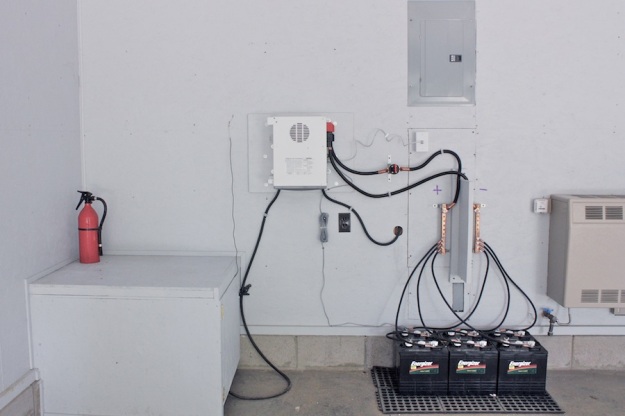9.26.2009- Saturday
We got going around 8 Am and I set to work on the inverter system with Dad. We took our time. Safety was paramount and we double and triple checked every thing that we hooked up. Dad made a trip to Iron Mountain and brought back a 3 foot ethernet cable to hook in the system to the wall outlet. In the end we couldn’t get it to work. After a long and frustrating day I helped hang roman shades, deer antlers, bear hides, and gun racks. With the house decorating done it was 10 Pm. I feel like a failure. The system isn’t working and I can’t figure it out.
9.27.2009-Sunday
Well, a little way in to the morning we finally got the inverter working. We switched the AC wiring in the unit and, Eureka! electricity! I was able to program the unit and begin to establish some system protocols. The control panel was mounted inside is really cool. A hard link to the inverter in the garage – I can program it, turn it on and off, turn the charger on and off… everything from inside the cabin. It also tells us the watts we are using as well as the voltage of the batteries and charge rate when the generator is on. Oh, and we can monitor the power output of the generator as well. I finally finished playing with the unit at 3 Pm, at which time I had programed it to pulse every 10 seconds to look for a load, using 75 watts as the minimum allowable load (the inverter pulses but won’t stay on unless a load of more than 75 watts is detected). The pulse saves energy, otherwise the inverter has to stay initialized at 200-250 watts all the time. The pulse allows us to have power at the flick of a switch. Otherwise we would have to walk over to the control panel, hit enter 2x, scroll down, and enable the inverter.
When Rudy and Bo stopped by yesterday on their four wheeler, while Dad was en route to Iron Mountain in search of an ethernet cable we gave them the tour. Rudy’s father owns the nearest cabin to ours. He noted the exposed bus bars and the gears in my head started to turn. Dad and I are discussing how to assemble an enclosure for the bus bars, or at least a full enclosure for the positive bus bar.
The next order of business is to develop an accurate way to gauge the charge state of our batteries from the voltage readout on control panel.
The lesson learned from this experience is that buying an inverter with built in safety mechanisms is never a bad thing. Our crossed wiring actually resulted in a hot ground. After returning to the manufacturers wiring diagram and studying it more closely was I able to correct the issue. NEVER attempt wiring if there are aspects of a diagram that you do not fully understand – look up symbols and abbreviations.

